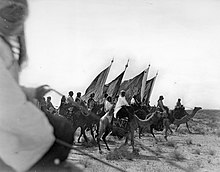Camel cavalry
This article may require copy editing for grammar, style, cohesion, tone, or spelling. (August 2023) |
Camel cavalry, or camelry (
Camel cavalry was a common element in
Early history
The first recorded use of the camel as a
More than sixty years later, Persian king Xerxes I recruited a large number of Arab mercenaries into his massive army during the Second Persian invasion of Greece, all of whom were equipped with bows and mounted on camels. Herodotus noted that the Arab camel cavalry, including a massive force of Libyan charioteers, numbered as many as twenty thousand. Employed from the nomadic tribes of Arabia and Syria, the camel-mounted mercenaries in Persian service fought as skirmishing archers, sometimes riding two to a camel.[4]
According to Herodian, the Parthian king Artabanus IV employed a unit consisting of heavily-armored soldiers equipped with lances (kontos) and riding on camels.[5]
The
The camel was used as a mount by pre-Islamic civilizations in the
Modern era


The British-officered Egyptian Camel Corps played a significant role in the 1898
The Italians used
The colonial authorities in
The Jordanian Desert Patrol still uses camels. [16]
The
Camels are still used by the Border Security Force for patrolling the remote areas of the Thar Desert lying along the India–Pakistan border in Rajasthan. Camels are purchased between the ages of 5 and 6 and trained at the Camel Training Centre at the BSF Frontier Headquarters at Jodhpur. They serve for 15–16 years and are retired from service at the age of 21. The camels used by the BSF are from three different breeds. The Jaisalmeris and the Bikaneris are used for border patrol, while the Nachnas are used for ceremonial duties. The BSF is also known for the yearly participation of its camel contingent in the Delhi Parade for the occasion of the Indian Republic Day since 1976. Inspector General KS Rathore is credited with enhancing the band's capabilities during his years as an inspector general from 1986 to 1989. The camel contingent has two groups, one consisting of camels ridden by border guards and the other being Border Security Force Camel Band, consisting of camels walking along with musicians who march on foot. Both of these elements perform together during the march of the camel contingent. The contingent generally consists of 90 camels[22][19][23]


See also
- Bikaner Camel Corps (Indian)
- Camel archer
- Dromedarii (Roman)
- Imperial Camel Corps (British Empire)
- Méhariste (French)
- Somaliland Camel Corps
- Sudan Defence Force
- Tropas Nómadas (Spanish)
- United States Camel Corps
- Zaptié (Italian)
- Dubats(Italian)
- Zamburak (camel-mounted artillery)
References
- ^ Herodotus (440 BC). The History of Herodotus. Rawlinson, George (trans.). Retrieved 4 December 2012.
He collected together all the camels that had come in the train of his army to carry the provisions and the baggage, and taking off their loads, he mounted riders upon them accoutred as horsemen. These he commanded to advance in front of his other troops against the Lydian horse; behind them were to follow the foot soldiers and, last of all, the cavalry. When his arrangements were complete, he gave his troops orders to slay all the other Lydians who came in their way without mercy but to spare Croesus and not kill him, even if he should be seized and offer resistance. Cyrus opposed his camels to the enemy's horse because the horse has a natural dread of the camel, and cannot abide either the sight or the smell of that animal. By this stratagem he hoped to make Croesus's horse useless to him, the horse being what he chiefly depended on for victory. The two armies then joined battle, and immediately, the Lydian war-horses, seeing and smelling the camels, turned round and galloped off, and so it came to pass that all Croesus' hopes withered away.
{{cite book}}: CS1 maint: numeric names: authors list (link) - ^ "Cameliers and camels at war". New Zealand History online. History Group of the New Zealand Ministry for Culture and Heritage. 30 August 2009. Retrieved 5 December 2012.
- ^ Jim Hicks, page 21 "The Persians", Time-Life Books, 1975
- ISBN 0-85045-271-6.
- ^ Herodian of Antioch, History of the Roman Empire (1961) pp.108-134. Book 4. CHAPTER XIV
- ISBN 978-1-4728-2176-8.
- ISBN 978-0-9963657-9-6.
- ISBN 978-1-4728-5049-2.
- ISBN 1-85532-166-1.
- ISBN 978-1-84603-206-6.
- ISBN 1-85532-166-1.
- ISBN 978-9960-899-55-8
- ISBN 085045-448-4.
- ISBN 978-1-78453-350-2.
- ^ Jose M. Bueno, pages 155–156, Uniformes Militares de la Guerra Civil Espanola, Liberia Editorial San Martin, Madrid 1971
- ^ Jordan's Bedouin 'desert forces' - Middle East - Al Jazeera English. 2010
- ^ a b c d e f Rikhye, Ravi (2003). "The Indian Army's Camel Troops 1948–75". Orders of Battle. Archived from the original on 14 June 2006.
- ^ "Rajputs State forces to modern Indian Army: A millennium of military service". Rajput Community Forum. 2020-01-05. Retrieved 2023-07-20.
- ^ a b c d Menon, Aparna (2015-12-01). "Did you know The Border Security Force has a camel band? Here's all about BSF and Its Camels". The Better India. Retrieved 2023-07-16.
- ^ "The 1971 Battle of Longewala: A night of confusion, Sam Manekshaw's order, Pakistan's folly". 3 December 2019.
- ^ "Years later, Longewala reminds the do-or-die battle | Jaipur News – Times of India". The Times of India. 18 December 2013.
- ISSN 0971-8257. Retrieved 2023-07-16.
- ^ "News Headlines, English News, Today Headlines, Top Stories". Hindustan Times. Retrieved 2023-07-20.

